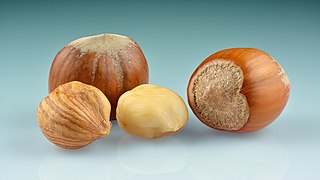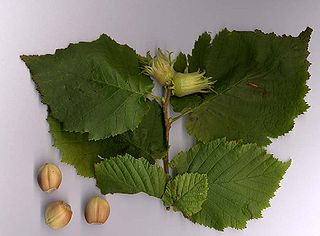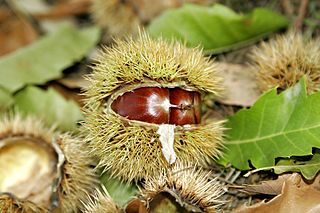
The areca nut is the fruit of the areca palm, which grows in much of the tropical Pacific, South Asia, Southeast Asia, and parts of east Africa. It is commonly referred to as betel nut, not to be confused with betel leaves that are often used to wrap it. Consumption has many harmful effects on health and is carcinogenic to humans. Various compounds present in the nut, including arecoline, contribute to histologic changes in the oral mucosa. It is known to be a major risk factor for cancers of the mouth and esophagus. As with chewing tobacco, use is discouraged by preventive efforts. Consumption by hundreds of millions of people worldwide – mainly of South Asian or Southeast Asian origins – has been described as a "neglected global public health emergency".

The nutcrackers (Nucifraga) are a genus of three species of passerine bird, in the family Corvidae, related to the jays and crows.

A nut is a fruit consisting of a hard or tough nutshell protecting a kernel which is usually edible. In general usage and in a culinary sense, a wide variety of dry seeds are called nuts, but in a botanical context "nut" implies that the shell does not open to release the seed (indehiscent).

The hazelnut is the fruit of the hazel tree and therefore includes any of the nuts deriving from species of the genus Corylus, especially the nuts of the species Corylus avellana. They are also known as cobnuts or filberts according to species.

Hazels are plants of the genus Corylus of deciduous trees and large shrubs native to the temperate Northern Hemisphere. The genus is usually placed in the birch family Betulaceae, though some botanists split the hazels into a separate family Corylaceae. The fruit of the hazel is the hazelnut.

Corylus avellana, the common hazel, is a species of flowering plant in the birch family Betulaceae, native to Europe and Western Asia. It is an important component of the hedgerows that were, historically, used as property and field boundaries in lowland England. The wood was traditionally grown as coppice, with the poles cut being used for wattle-and-daub building, and agricultural fencing.

Corylus maxima, the filbert, is a species of hazel in the birch family Betulaceae, native to southeastern Europe and southwestern Asia, from the Balkans to Ordu in Turkey.

Corylus colurna, the Turkish hazel or Turkish filbert, is a deciduous tree native to southeast Europe and southwest Asia, from the Balkans through northern Turkey to northern Iran. It is also found growing wild in the forests of Western Himalayan range in the north Indian state of Himachal Pradesh particularly in the temperate regions of districts of Kullu, Shimla, Kinnaur district and Chamba district.

Corylus cornuta, the beaked hazelnut, is a deciduous shrubby hazel with two subspecies found throughout most of North America.

The calybium and the cupule make up the accessory fruit of flowering plants in the family Fagaceae. These two parts derive from different flower components.

Corylus heterophylla, the Asian hazel, is a species of hazel native to eastern Asia in northern and central China, Korea, Japan, and southeastern Siberia.

Corylus americana, the American hazelnut or American hazel, is a species of deciduous shrub in the genus Corylus, native to the eastern and central United States and extreme southern parts of eastern and central Canada.

Corylus johnsonii is an extinct species of hazel known from fossil fruits found in the Klondike Mountain Formation deposits of northern Washington state, dated to the early Eocene Ypresian stage. Based on described features, C. johnsonii is the oldest definite species in the genus Corylus.

Corylus chinensis, common names Chinese filbert and Chinese hazel, is a deciduous tree native to western China. This tree is considered vulnerable due of its rarity.
Coryloides is an extinct genus of flowering plants in the hazelnut family, Betulaceae, containing the single species Coryloides hancockii. The species is solely known from the middle Eocene sediments exposed in north central Oregon and was first described from a series of isolated fossil nuts in cherts.

Corylus jacquemontii is a species of hazel, found in Asia, within the Himalayas and from Afghanistan through to W. Nepal. It is a small tree or shrub, with grey bark, ovate or obovate (teardrop-shaped) leaves, small flowers and small edible nuts, grouped in small clusters.

Tusheti Strict Nature Reserve is located in the Tusheti Mountainous region in the north-eastern part of Georgia. Visitors center is located in village lower Alvani, Akhmeta Municipality.
















